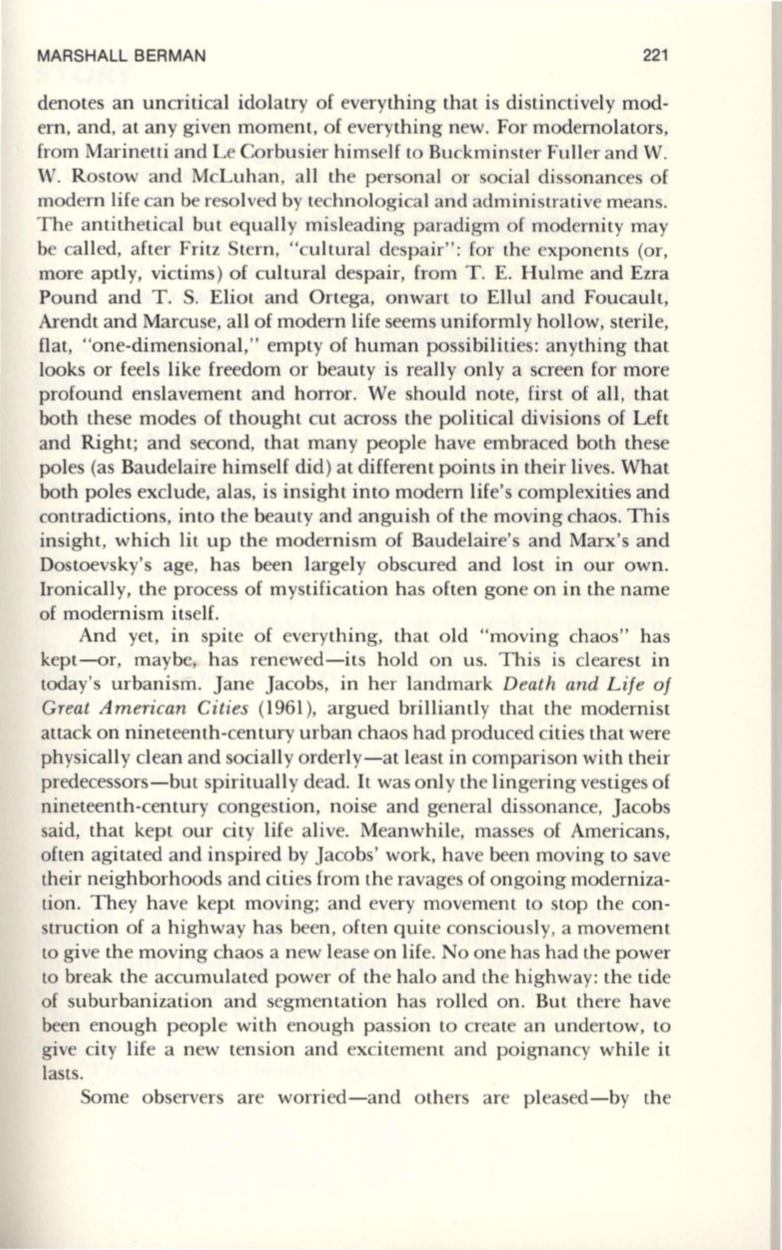
MARSHALL BERMAN
221
denotes an uncritical idolatry of everything that is distinctively mod–
ern, and, at any given moment, of everything new. For modernolators,
from Marinetti and Le Corbusier himself
to
Buckminster Fuller and W.
W. Rostow and McLuhan, all the personal or social di onances of
modern life can be resolved by technological and administrative means.
The antithetical but equally misleading paradigm of modernity may
be called, after Fritz Stern, "cultural despair": for the exponents (or,
more aptly, victims) of cultural despair, from
T.
E. Hulme and Ezra
Pound and
T.
S. Eliot and Ortega, onwart to Ellul and Foucault,
Arendt and Marcuse, all of modern life seems uniformly hollow, sterile,
flat, "one-dimensional," empty of human possibilities: anything that
looks or feels like freedom or beauty is really only a screen for more
profound enslavement and horror. We should note, first of all, that
both these modes of thought cut across the political divisions of Left
and Right; and second, that many people have embraced both these
poles (as Baudelaire himself did) at different points in their lives. What
both poles exclude, alas, is insight into modern life's complexities and
contradictions, into the beauty and anguish of the moving chaos. This
insight, which lit up the modernism of Baudelaire's and Marx's and
Dostoevsky's age, has been largely obscured and lost in our own.
Ironically, the process of mystification has often gone on in the name
of modernism itself.
And yet, in spite of everything, that old "moving chaos" has
kept-or, maybe, has renewed-its hold on us. This is clearest in
today's urbanism. Jane Jacobs, in her landmark
Death and Life of
Great American Cities
(1961), argued brilliantly that the modernist
attack on nineteenth-century urban chaos had produced cities that were
physically clean and sociall y orderly-at least in comparison with their
predecessors-but spiritually dead.
It
was only the lingering vestiges of
nineteenth-century congestion, noise and general dissonance, Jacobs
said, that kept our city life alive. Meanwhile, masses of Americans,
often agitated and inspired by Jacobs' work, have been moving to save
their neighborhoods and cities from the ravages of ongoing moderniza–
tion. They have kept moving; and every movement
to
stop the con–
struction of a highway has been, often quite consciously, a movement
to give the moving chaos a new lease on life. No one has had the power
LO
break the accumulated power of the halo and the highway: the tide
of suburbanization and segmentation has rolled on. But there have
been enough people with enough passion
to
create an undertow,
to
give city life a new tension and excitement and poignancy while it
lasts.
Some observers are worried-and others are pleased-by the


